Yesterday, having found decent wi-fi at the Reagan National Airport (DCA) terminal, I began telling you about the main event in my week-long trip to Washington for the Hubble 25th Anniversary NASA Social. Part One brought you the events of the NASA press conference at the Newseum on April 23rd.
After the news conference was over and we were done schmoozing with astronauts and astrophysicists, we were free to wander around the Newseum for an hour or so, then we were loaded on a bus and driven out to Greenbelt, MD, the home of NASA’s Goddard Space Flight Center.
First stop at Goddard was the viewing room overlooking the clean room where the James Webb Space Telescope (JWST) is being built, tested, and assembled. I’ve seen the clean rooms at JPL where planetary spacecraft have been built, also impressive places. We were told that this was the largest known clean room, the implication being that there might be other, not-quite-so-public government agencies that also build and launch large satellites who might have one larger, but if they told us they would have to kill us.
Here you can see part of the flight hardware, the Integrated Science Instrument Module (ISIM). The ISIM will be a large structure at the back of the telescope, behind the mirror, holding all of the scientific instruments that are looking at the image coming off of the main mirror, the secondary mirror (out in front on that tripod structure), and back through the center of the main mirror.
This is the model of JWST in the observation room. You can see how, unlike the Hubble Space Telescope (HST), the mirror for JWST isn’t one solid piece. In order to get this massively huge telescope into a very confined rocket to launch, it’s been designed to fold up like the biggest, most expensive origami piece ever built.
The full-sized mirror will be made of eighteen smaller mirrors, all mounted and actively controlled to make sure that they’re working in unison. The other major feature is the sun shield, seen here as five layers of material underneath the telescope.
The short version is that JWST is an infrared telescope, unlike HST which is primarily an optical telescope. While HST sees pretty much the same bands of light we see, JWST will see longer wavelength light, what we perceive as heat.
Since JWST is seeing heat, anything warm nearby will be like having a bright light near an optical telescope. It would fog and degrade the seeing. In order to counter this, JWST needs to be kept as cold as possible. This will be accomplished by the use of the huge sun shield. Hidden permanently (we hope) on the shadow side of the shield, JWST will chill down to just a few degrees above absolute zero.
The sun shield will be made of multiple thin layers of Kapton, which is incredibly thin as well as opaque to sunlight. The equivalent of an SPF of 10,000, the thinness of Kapton allows it to be folded multiple times in order to fit into the launch vehicle. Remember the Mythbusters episode where they tried to fold a sheet of paper over and over and couldn’t do it past a certain point? Same problem – the thinner the material, the more you can fold it.
As for size, while HST is the size of a school bus, JWST is the size of a 747. To see a picture of the Goddard team along with a full-sized model of JWST, go here.
On the wall behind Laura Betz and Maggie Masetti, our hostesses for this part of the presentation, is a partial model of the JWST mirror. Each of the mirrors is over four feet wide, and altogether the primary mirror is far too large to fit on the wall here. In comparison, the HST mirror is about seven feet wide, so it would comfortably fit between floor and ceiling.
Yesterday I mentioned a misconception about HST images, where people would not see the planetary nebula and galaxies with the naked eye as they would in the image, because the image is made of hours of light collection using a huge aperture, where the human eye is small and unable to integrate an image over time.
Another big difference between HST and JWST is that JWST will not be in low Earth orbit (LEO). While it’s (relatively) easy to fix and service a spacecraft in LEO (there were five servicing shuttle missions to HST), it also means that there’s a huge (and warm) planet filling half of your sky all the time. JWST will be put into orbit at the L-2 point, a spot roughly a million miles from Earth. L-2 is a spot between the Earth and the Sun where their gravitational pulls balance out.
That solves a lot of observational problems, but it brings up a lot of operational “challenges.” There are currently no plans to ever be able to service or repair JWST, so it’s a one-shot deal. (I noted that plans change, and we are very clever monkeys when backed into a corner.)
The feed from that little webcam up there is available to the public if you want to see what’s happening in the clean room. Of course, it’s called a Webb-cam.
More importantly, those big silver containers are not pods containing alien bodies being prepared to take over humanity. (Or at least, that’s what they said.) They in fact hold the mirror segments that have been assembled and are now awaiting assembly. Over the next two years you might want to check in occasionally to see how assembly is proceeding.
Getting a telescope that big, with all of those folded-up parts, into a package small enough so that it can be launched into space on an Ariane 5 rocket, has got to be a fascinating process to watch. JWST is scheduled to launch in 2018 from French Guiana. With luck both JWST and HST will be working concurrently for at least a year or two. Unlike HST (Happy 25th Birthday!), JWST is only expected to last five to ten years before something fails or the spacecraft runs out of maneuvering fuel.
Gee, for all of those billions of dollars spent on building it, maybe it would be worth figuring out how to spend a bit more and send a crewed Orion out there to refuel and refurbish. Just sayin’!
Sent outward and onward, we found the Space Environment Simulator (SES) facility. This chamber actually goes down a floor or more and can be cooled to 20°K, which is -424°F, or heated to 176°F (80°C). This simulates the temperature ranges that JWST will have to endure at L2. In addition to simulating the extreme temperatures that JWST will live in, the SES can be evacuated down to 10^-7 torr. That’s one ten-billionth of an atmosphere.
While all of this is going on, the SES uses massive amounts of liquid nitrogen and liquid helium to do the cooling. You know those big trucks you see on the freeways carrying liquid gases? (Or the one that gets crashed to freeze the Terminator at the end of T2 – c’mon, you know that you’ve seen it!) The SES uses two of those a day during testing.
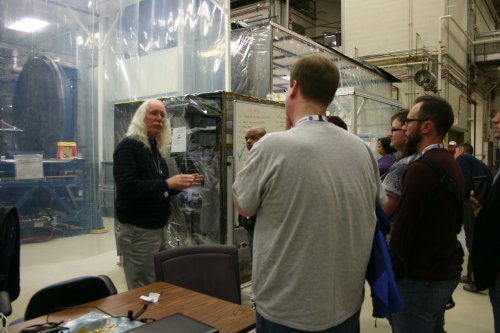 Dr. Dennis Reuter told us about OSIRIS-REx, the Origins-Spectral Interpreation-Resource Identification-Security-Regolith Explorer. As well as being the first US mission to attempt to rendezvous with an asteroid and bring back samples, it’s also proof that the geniuses at NASA can come up with an acronym for ANYTHING.
Dr. Dennis Reuter told us about OSIRIS-REx, the Origins-Spectral Interpreation-Resource Identification-Security-Regolith Explorer. As well as being the first US mission to attempt to rendezvous with an asteroid and bring back samples, it’s also proof that the geniuses at NASA can come up with an acronym for ANYTHING.
OSIRIS-REx is scheduled to launch in September 2016 to rendezvous with the asteroid Bennu, an asteroid with a non-zero probability of impacting Earth in the late 22nd Century. (No need to start packing just yet.) It will study what the asteroid is made of (the better to deflect it or otherwise keep it from slamdancing Secaucus) as well as bring back a small sample to be analyzed for organic materials left over from the early creation of the solar system.
This was also one of the nosiest rooms in the world and I only heard about one of every three or four words. The bottom line is that OSIRIS-REx is being tested and assembled now, must hit its launch window in sixteen months, and will give us invaluable data on what we’re dealing with if/when some asteroid draws a bulls eye on our little slice of heaven.
The “close-up” of the flight hardware, as seen through the plastic tent protecting it from outside contaminants. (Like us.) Say hello to Bennu for us!
Next, more on HST’s history and some of the other cutting edge projects being worked on at Goddard.

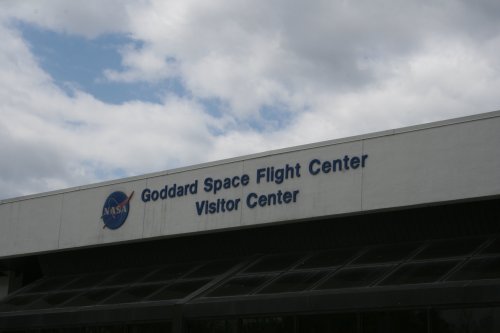
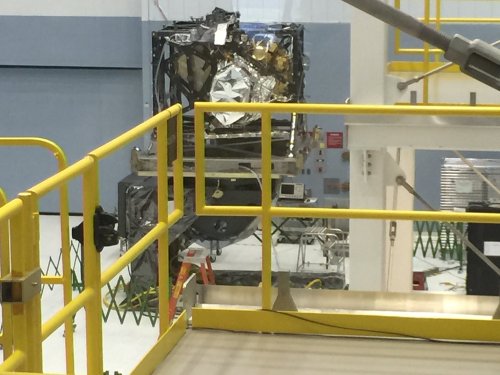
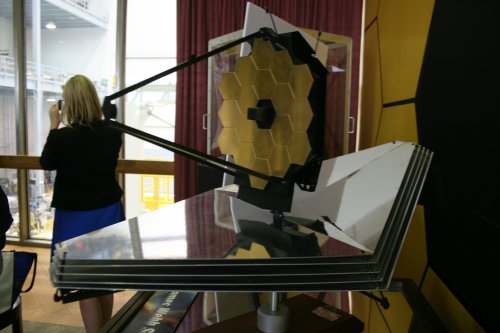
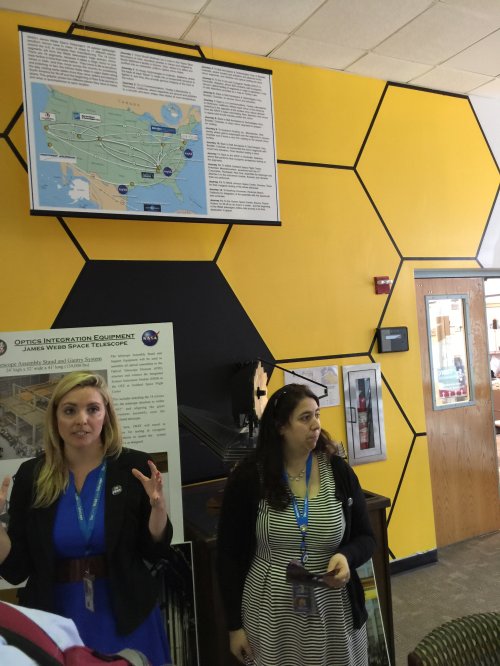
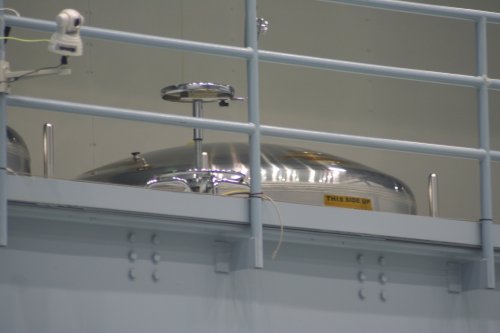
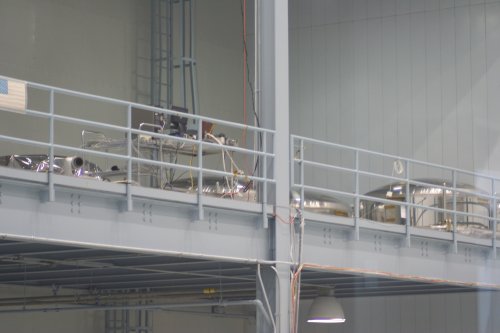
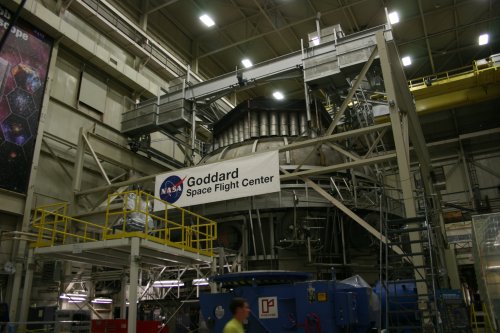
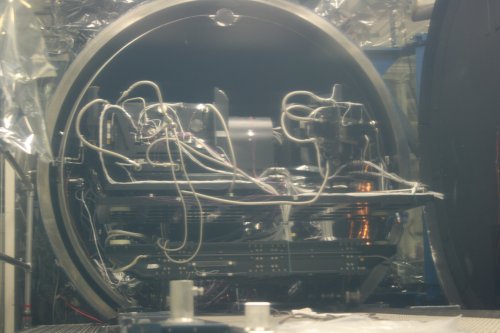
wow, i would love to visit a place like this 🙂
LikeLike
Just one small correction – JWST is much smaller than a 747 – it’s actually about half the size of a 737 but less than 8% of the mass of a 737!
LikeLiked by 1 person
Thanks for the correction. It’s amazing how much they can do with so little mass. They gave us a piece of the sun shield material to pass around – so light it makes commercial Mylar look like burlap in comparison.
LikeLike
Pingback: Fade To Indigo | We Love The Stars Too Fondly